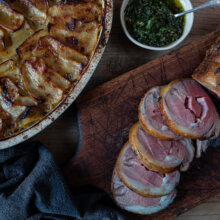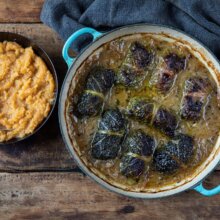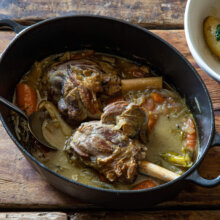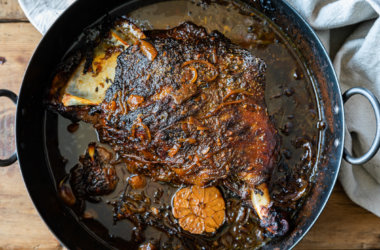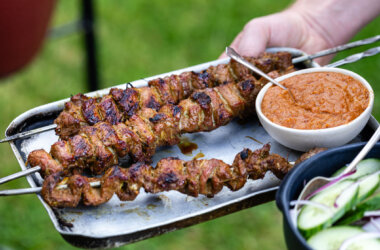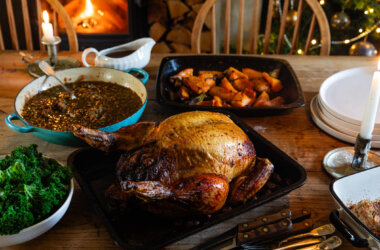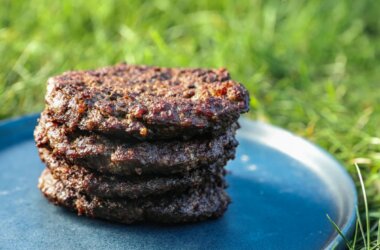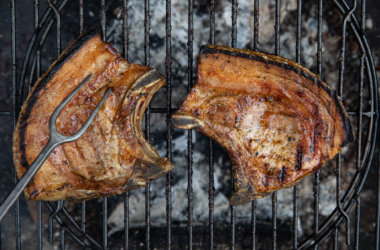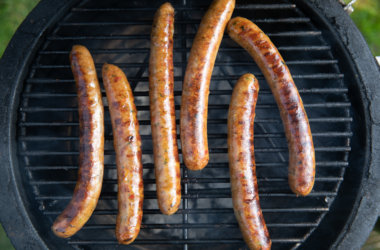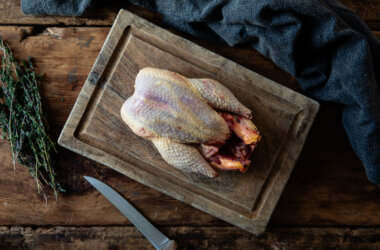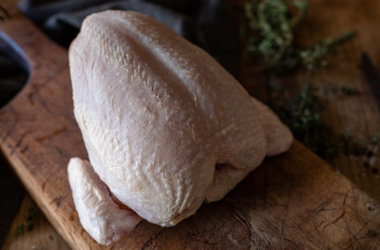Whole Lamb Leg Recipe: A Classic Roast with a Twist: A whole leg of lamb is one of the most iconic roasting joints, worthy of any celebratory meal. Cooked on the bone with its generous layer of fat, it delivers incredibly juicy, flavourful meat that’s hard to beat.
But perhaps it’s time to shake things up a little? Instead of the usual roast potatoes, why not try something different – something equally satisfying but with a fresh perspective? This recipe pairs roasted parsnips with barley, a wonderfully versatile grain that truly shines when simmered in rich lamb stock. The deep, savoury notes of the lamb enhance the barley’s texture, creating a comforting and wholesome accompaniment.
One crucial element here is balance – a generous splash of high-quality vinegar at the end lifts the dish, cutting through the richness and bringing everything together beautifully. If you’re looking for a new take on a traditional roast, this might just be it.

Serves 6 (with some lamb for leftovers)
Ingredients
For the Lamb Stock
For the Barley
Method
Start with the stock (You may well want to make this a day in advance as it will take a few hours to cook and so relieve you of an extra task on the morning of the day in question)
- Preheat your oven to 180°C.
- Lay the lamb bones on a roasting tray and place in the oven for 25 minutes.
- Remove the tray from the oven and allow to cool slightly before tipping them and their fat into a sensibly sized pot.
- Cover with water and bring up to a boil. Turn down to a simmer and leave for 10 minutes.
- After 10 minutes, use a ladle to skim off any scum that has formed on the surface.
- Add the carrot, onion, garlic and bay leaves.
- Allow to simmer very slowly for 3-4 hours, with a lid slightly ajar so not too much liquid evaporates.
- Remove from the heat and allow to sit and cool for 30 minutes.
- Pass through a sieve and discard the bones and vegetables.
For the lamb:
- Remove the lamb leg from the fridge and its packaging and allow to reach room temperature. I would suggest at least 4 hours before cooking.
- Preheat your oven to 170°C.
- Season the lamb leg well with salt.
- In a large roasting tray, lay the parsnips, shallots and a few sprigs of rosemary. Season them with salt, give them a drizzle with olive oil, and give them a little shake.
- Place the lamb leg on top and also give this a good drizzle of olive oil.
- Place the tray in the oven and set a timer for 45 minutes.
- Take the tray out of the oven and turn the parsnips and shallots over, exposing a different side of them to the heat. Also, take this opportunity to baste the lamb leg in some of its own fat and juices.
- Return the tray to the oven for another 45 minutes.
- Remove the tray and baste a final time before leaving somewhere warm to rest for at least 1 hour.
To make the barley:
- Add the butter to a large, heavy-bottomed pan and set it over a medium heat.
- Take the stalks of the cavolo nero and finely chop them. Add these, plus the onions and garlic to the pan and season with a pinch of sea salt.
- Allow this to cook, stirring regularly, with a lid on, for about 15 minutes. Until it is soft and sweet but not taking on any colour.
- Add the barley and stir through the base. Then add the white wine bring to the boil for a moment and then add enough stock to cover the barley by about 2 cm. Season again with a pinch of salt and allow to come to a simmer.
- Simmer for about 20-25 minutes, with a slightly ajar lid or a cartouche. If the barley looks too dry at any point, add a splash more stock.
- Take the washed cavolo nero leaves and run a knife through them. Add the leaves to the barley and cover with a lid. Cook for 5 minutes, stirring occasionally — the cavolo nero should wilt into the barley.
- Grate a little parmesan into the barley to help thicken it slightly and of course, add a little extra depth of flavour.
- Check for seasoning and adjust as necessary. As previously stated, adding a good quality white wine vinegar is crucial for me and brings the whole thing to life!
- Re-heat the parsnips and shallots and carve the lamb. You are ready to eat.
